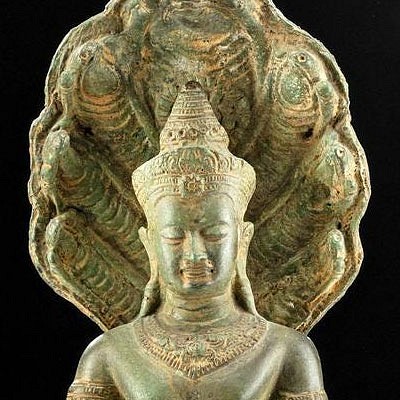Fine Huari Painted Wood & Textile Mummy Mask, ex-Museum
Lot 167
About Seller
Artemis Gallery
686 S Taylor Ave, Ste 106
Louisville, CO 80027
United States
Selling antiquities, ancient and ethnographic art online since 1993, Artemis Gallery specializes in Classical Antiquities (Egyptian, Greek, Roman, Near Eastern), Asian, Pre-Columbian, African / Tribal / Oceanographic art. Our extensive inventory includes pottery, stone, metal, wood, glass and textil...Read more
Estimate:
$1,200 - $1,800
Absentee vs Live bid
Two ways to bid:
- Leave a max absentee bid and the platform will bid on your behalf up to your maximum bid during the live auction.
- Bid live during the auction and your bids will be submitted real-time to the auctioneer.
Bid Increments
| Price | Bid Increment |
|---|---|
| $0 | $25 |
| $300 | $50 |
| $1,000 | $100 |
| $2,000 | $250 |
| $5,000 | $500 |
| $10,000 | $1,000 |
| $20,000 | $2,500 |
| $50,000 | $5,000 |
| $100,000 | $10,000 |
| $200,000 | $20,000 |
About Auction
By Artemis Gallery
Aug 10, 2021
Set Reminder
2021-08-10 12:00:00
2021-08-10 12:00:00
America/New_York
Bidsquare
Bidsquare : Museum-Deaccession | Asian & Pre-Columbian
https://www.bidsquare.com/auctions/artemis-gallery/museum-deaccession-asian-pre-columbian-7316
An interesting mix of de-accessioned Asian and Pre-Columbian Art from The Ashland University Museum in Ashland, OH, originally donated between 1994 to 1998. All lots from the Museum have been noted, as such. Artemis Gallery info@artemisgallery.com
An interesting mix of de-accessioned Asian and Pre-Columbian Art from The Ashland University Museum in Ashland, OH, originally donated between 1994 to 1998. All lots from the Museum have been noted, as such. Artemis Gallery info@artemisgallery.com
- Lot Description
Pre-Columbian, Southern Peru, Huari (Wari) culture, ca. 600 to 900 CE. A hand-carved wooden mummy mask of a grand, trapezoidal size with textile adornments woven from both natural cotton and camelid (alpaca or llama) fibers. The red-brown mask features a rounded chin, white-painted eyes with black pupils, a slender nose protruding from the middle, and a slit form mouth flanked with diagonal black and white stripes. At each temple is a braided textile strand with a maroon and white tassel. Surrounding the forehead are a few textile panels with inversely corresponding stepped motifs, loose fringes, deep maroon and yellow hues, or a gauze-like weft. A magnificent artifact from the ancient Huari! Size: 11.25" W x 12" H (28.6 cm x 30.5 cm)
For the people of the Andes, death was not the end of life. It marked the transition into a new existence in the underworld. This transition was ensured through funerary rites and the careful preparation of the funerary bundle and tomb, so that society's leaders could be transformed into ancestors.
Display stand shown in photos is for photography purposes only.
Provenance: ex-Ashland University Museum, Ashland, Ohio, USA, donated to Ashland University between July 1994 to December 1998
All items legal to buy/sell under U.S. Statute covering cultural patrimony Code 2600, CHAPTER 14, and are guaranteed to be as described or your money back.
A Certificate of Authenticity will accompany all winning bids.
PLEASE NOTE: Due to recent increases of shipments being seized by Australian & German customs (even for items with pre-UNESCO provenance), we will no longer ship most antiquities and ancient Chinese art to Australia & Germany. For categories of items that are acceptable to ship to Australia or Germany, please contact us directly or work with your local customs brokerage firm.
Display stands not described as included/custom in the item description are for photography purposes only and will not be included with the item upon shipping.
#166229Minor abrasions and encrustations to obverse and verso, with fraying and light staining to textile panels, otherwise intact and excellent. Great preservation to overall form and textile adornments.Condition
- Shipping Info
-
All shipping is handled in-house for your convenience. Your invoice from Artemis Gallery will include shipping calculation instructions. If in doubt, please inquire BEFORE bidding for estimated shipping costs for individual items.
-
- Buyer's Premium



 EUR
EUR CAD
CAD AUD
AUD GBP
GBP MXN
MXN HKD
HKD CNY
CNY MYR
MYR SEK
SEK SGD
SGD CHF
CHF THB
THB













